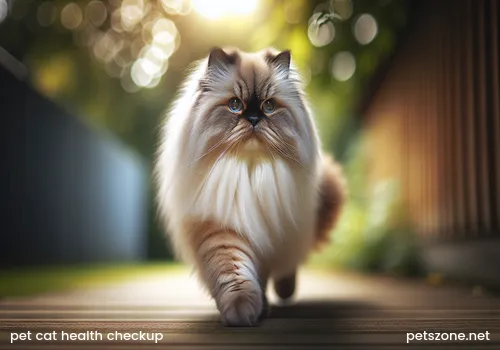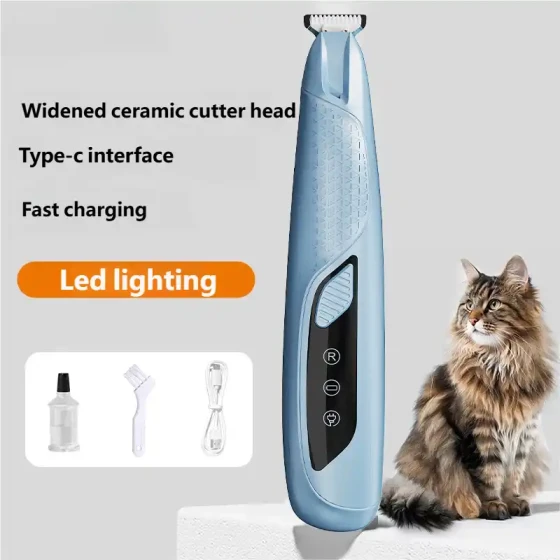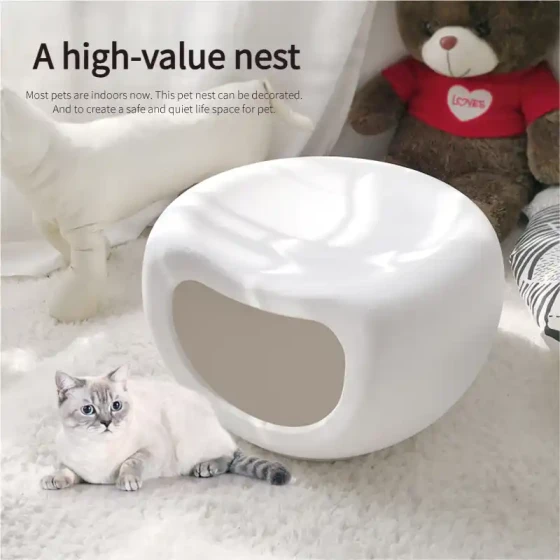Pet Cat Physical Examination_Notes for Taking Your Cat for a Comprehensive Checkup
Regular comprehensive physical examinations for your beloved cat are a key step to ensure their health, longevity, and quality of life. It’s like giving the “little master” at home a yearly “full-body checkup,” helping us detect potential health issues early and prevent problems, allowing our furry friends to accompany us longer and live more comfortably.
Cat Physical Examination: Why Is It So Important?

Cats are naturally masters of endurance; they skillfully hide pain and discomfort, which stems from their survival instincts in the wild—showing weakness could invite danger. Therefore, many diseases in cats initially have no obvious symptoms. By the time we can visually observe abnormalities, the condition may have already progressed to a more serious stage. Annual physical exams act like equipping cats with a “health radar,” helping veterinarians find hidden health risks through professional examinations.
Physical examinations are not just about treating illness, but also a “vaccine” of prevention:
- Early warning: Many chronic diseases, such as kidney disease, diabetes, hyperthyroidism, can be detected early or even at subclinical stages through regular blood routine and biochemical parameter monitoring. Early intervention greatly slows disease progression and improves treatment outcomes.
- Health baseline assessment: Each exam’s data forms a “health record” for your cat, helping veterinarians understand individual physiological parameters and quickly identify abnormalities when they arise.
- Parasite control: Exams usually include fecal tests to timely detect internal parasites, guiding owners in effective deworming.
- Vaccination assessment: Vets will provide personalized vaccine recommendations based on your cat’s health status, age, and living environment to ensure comprehensive protection.
- Nutrition and weight management: Vets assess body condition scores and offer scientific diet advice, avoiding health risks caused by obesity or emaciation.
What Does a Pet Cat Physical Exam Check? — Revealing the "Meow Star" Health Report
A comprehensive cat checkup usually includes the following core parts:
1. Basic Physical Examination (Physical Examination)
This is the “appetizer” for every checkup, where the vet thoroughly examines the entire cat.
- Observe mental state: Is the cat lively? How does it react to the environment?
- Weighing and temperature measurement: Weight fluctuation is an important health indicator; elevated temperature may indicate infection or inflammation.
- Examine eyes, ears, mouth, and nose: Check for discharge, inflammation, tartar, bad breath, etc.
- Palpate lymph nodes and abdomen: Feel for enlargement or abnormal masses.
- Auscultate heart and lungs: Check heartbeat rhythm, presence of murmurs, and clarity of lung sounds.
- Assess skin and fur: Check for hair loss, dandruff, parasites (like fleas, mites), or skin lesions.
- Check joints and gait: Observe if walking is normal, any joint pain or stiffness.
Additional note: When palpating the abdomen, vets carefully feel the size, shape, and texture of intestines, kidneys, bladder, and other organs, which requires rich clinical experience for accurate judgment.
2. Blood Tests (Blood Work)
Blood is the “barometer” of a cat’s health; analyzing blood samples provides abundant key information.
- Complete Blood Count (CBC): Checks red and white blood cells and platelets, revealing anemia, infection, inflammation, or clotting abnormalities. Abnormal white cell counts may indicate infections or immune system problems.
- Chemistry Panel: Evaluates liver, kidney, pancreas function; blood sugar levels; electrolyte balance. For example, elevated kidney markers (creatinine, BUN) may indicate kidney dysfunction; raised liver enzymes (ALT, ALP) may relate to liver damage.
- FIV/FeLV Test: Testing for feline immunodeficiency and leukemia viruses is crucial as these viral diseases significantly impact cat health. This is especially important for newly adopted or unknown-source cats.
3. Urinalysis (Urinalysis)
Urine tests reflect urinary system health and indirectly kidney function and some metabolic diseases.
- Specific gravity: Assesses kidney concentrating ability.
- Urine composition: Checks for red or white blood cells, crystals, bacteria, proteins. Presence of many crystals or blood may signal urinary tract infection or stones.
4. Fecal Examination (Fecal Examination)
Primarily detects intestinal parasites (e.g., roundworms, tapeworms, coccidia) or bacterial infections. Even indoor cats may contact parasite eggs via shoe soles or food.
5. Imaging Examinations (Imaging)
Depending on the cat’s age, condition, or suspected disease, vets may recommend X-rays or ultrasound exams.
- X-rays: Evaluate bones, joints, thoracic cavity (heart and lungs), and abdominal organs’ size and position, e.g., detecting heart enlargement, bladder stones, or bone lesions.
- Ultrasound: Provides clearer internal views of organs like liver, kidneys, bladder, gastrointestinal tract to detect abnormalities.
6. Other Optional Tests
- Thyroid function tests: Recommended for middle-aged to senior cats, especially those with weight loss, increased appetite, or hyperactivity symptoms, to check thyroid hormone levels.
- Blood pressure measurement: Helps diagnose and monitor hypertension, which may be secondary to kidney disease, hyperthyroidism, etc.
- Dental examination and cleaning: Many cats suffer from some degree of periodontal disease; regular exams and professional cleaning are vital for oral health.
- Virus antibody titer test: Evaluates vaccine immunity level to determine if booster shots are needed.
“Pre-trip Notice” and “Precautions” for Taking Your Cat for a Physical Exam
1. Appointment and Communication:
* Book in advance: Especially on weekends or holidays, veterinary clinics are usually busy.
* Detailed communication: When making an appointment, inform the doctor of your cat’s age, breed, medical history, spay/neuter status, and any abnormal symptoms.
2. Preparation:
* Fasting and water restriction: Usually require no food for 8–12 hours (except kittens or special cases), and no water for 2–4 hours. This ensures blood test accuracy and prepares for sedation or anesthesia to prevent vomiting. Please follow vet’s advice.
* Collect feces and urine: If requested by the vet, collect fresh feces and urine samples beforehand to save waiting time. Fresh samples improve test accuracy.
* Bring vaccination records and medical history: Helps the vet understand your cat’s health background.
* Prepare a comfortable carrier: It should be spacious enough for your cat to turn around. Placing familiar bedding or a blanket with their scent can reduce anxiety.
* Cat’s mood: Some cats are shy or stressed; place catnip or pheromone sprays in the carrier beforehand to help relax them. For very nervous cats, consult the vet about mild sedatives.
3. Arrival at the Clinic:
* Stay calm: Your mood directly affects your cat. Keep calm and soothe your cat gently.
* Ensure safety: Even normally docile cats may become aggressive under stress or in unfamiliar environments. Always secure them in the carrier and do not let them roam freely.
* Be patient and cooperative: The vet may ask detailed questions, so honestly report your cat’s diet, elimination, and behavior habits.
4. Post-examination Care:
* Follow medical advice: Based on the exam results, the vet will provide treatment plans, diet recommendations, or lifestyle adjustments.
* Monitor your cat: If blood draws or other procedures were done, watch your cat’s mental state, appetite, and elimination at home for any abnormal reactions.
Frequency and Cost of Cat Physical Exams
Frequency of exams:
- Kittens (under 1 year): After completing vaccinations and deworming, a basic exam is recommended at 6–8 months old.
- Adult cats (1–7 years): Annual routine check-ups are recommended.
- Senior cats (over 7 years): Biannual exams are advised. Senior cats have declining physiological functions and are more prone to chronic diseases.
Exam costs:
The cost varies depending on region, clinic level, cat’s age, chosen exam items, and whether imaging is included. In China, basic exam packages (including physical exam, CBC, chemistry, fecal test) typically range from several hundred to over a thousand RMB. Additional tests like FIV/FeLV, thyroid function, X-rays, or ultrasound will increase the cost. It is advisable to consult local clinics ahead for detailed packages and pricing.
Tip: Many clinics offer annual exam packages or membership discounts—owners should pay attention and choose the most cost-effective services.
Frequently Asked Questions (FAQ)
Q1: My cat looks healthy; is annual exam still necessary?
A1: Absolutely! As mentioned, cats hide discomfort well. Many chronic diseases have almost no early symptoms. When you notice abnormalities, the best treatment window may have passed. Annual exams help vets discover hidden health dangers.
Q2: Will fasting and water restriction before exams starve my cat?
A2: Short fasting does not harm cats. Fasting prevents food from affecting blood test results (e.g., glucose, triglycerides) and reduces vomiting or aspiration risks during sedation or anesthesia.
Q3: What if my cat is too aggressive and resists the exam?
A3: This is a common “sweet trouble” for many owners. First, choose an experienced, cat-friendly clinic. Secondly, try “desensitization training” with the carrier to get your cat used to it. For highly stressed cats, consult the vet about mild sedatives or supportive methods. Professionals will skillfully complete the exam.
Q4: What are the differences in exams between kittens and senior cats?
A4: Kitten exams focus more on infectious disease screening (FIV/FeLV), parasite detection, and vaccination planning. Senior cat exams emphasize chronic disease screening (kidney disease, hyperthyroidism, heart disease, arthritis), tumor screening, and dental health assessment.
Q5: What if I don't understand the exam report metrics?
A5: Don’t worry! After the exam, the vet will explain the report in detail and what each metric means. If you have questions, always ask the vet on site for professional answers. Remember, a professional vet’s interpretation is the most reliable.
Conclusion
Regular checkups for your cat demonstrate the deepest care from a responsible owner. It’s not just a financial investment, but a solemn commitment to your cat’s life and health. Scientific physical exams allow comprehensive understanding of your cat’s condition, detecting and solving problems timely, enabling these lovely fur kids to healthily and happily accompany you through more wonderful times. After all, the joy they bring cannot be measured in money. Regular checkups give your cat a safer future!
References:
- American Veterinary Medical Association (AVMA) recommendations on pet health examinations.
- International Society of Feline Medicine (ISFM) guidelines on feline health management.
- Health examination guidelines from several well-known domestic veterinary hospitals.
- Relevant pet health popular science books and professional veterinary articles.
-560x560.webp)




